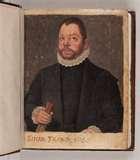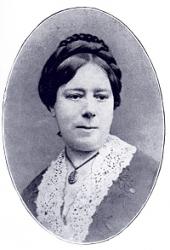- |
User Links
Ye Heavens, O Haste Your Dews to Shed

Ye heavens, O haste your dews to shed
Author: Johann Campanus; Author: Johann Franck (1653); Translator: Catherine Winkworth (1863)Tune: VOM HIMMEL HOCH
Published in 9 hymnals
Printable scores: PDF, MusicXMLAudio files: MIDI
Representative Text
Ye heav'ns, oh haste your dews to shed,
Ye clouds, rain gladness on our head,
Thou earth, behold the time of grace,
And blossom forth in righteousness!
O living Sun, with joy break forth,
And pierce the gloomy clefts of earth;
Behold, the mountains melt away
Like wax beneath Thine ardent ray!
O Life-dew of the Churches, come,
And bid this arid desert bloom!
The sorrows of Thy people see,
And take our human flesh on Thee.
Refresh the parch'd and drooping mind,
The broken limb in mercy bind,
Us sinners from our guilt release,
And fill us with Thy heavenly peace.
O wonder! night no more is night!
Comes then at last the long'd-for light?
Ah yes, Thou shinest, O true Sun,
In whom are God and man made one!
Author: Johann Campanus
 Campanus, Johann, was born on June 24, c. 1565, at Wodnian in Bohemia. At the Uni¬versity of Prag (Prague), he graduated b.a. 1592, M.A. 1596. In 1592 he became master at Iglau, thereafter at Teplitz, and then professor at Königingratz. He was in 1596 appointed Rector of the St. Heinrich school, in the Neustadt, Prag, and in 1600 Rector at Kuttenberg. Ultimately he became Professor of Greek and Latin and of Bohemian History in the University of Prag, where he was some time Dean of the Philosophical Faculty, and in 1612 Rector of the University. He died at Prag, Dec. 13, 1622.
Brought up at Wodnian as a Hussite, he became a Lutheran; then a Calvinist; was in 1619 assessor of the Utraquist Consistory of the Teynkirche in the Altstadt, Prag… Go to person page >
Campanus, Johann, was born on June 24, c. 1565, at Wodnian in Bohemia. At the Uni¬versity of Prag (Prague), he graduated b.a. 1592, M.A. 1596. In 1592 he became master at Iglau, thereafter at Teplitz, and then professor at Königingratz. He was in 1596 appointed Rector of the St. Heinrich school, in the Neustadt, Prag, and in 1600 Rector at Kuttenberg. Ultimately he became Professor of Greek and Latin and of Bohemian History in the University of Prag, where he was some time Dean of the Philosophical Faculty, and in 1612 Rector of the University. He died at Prag, Dec. 13, 1622.
Brought up at Wodnian as a Hussite, he became a Lutheran; then a Calvinist; was in 1619 assessor of the Utraquist Consistory of the Teynkirche in the Altstadt, Prag… Go to person page >Author: Johann Franck
 Johann Franck (b. Guben, Brandenburg, Germany, 1618; d. Guben, 1677) was a law student at the University of Köningsberg and practiced law during the Thirty Years' War. He held several positions in civil service, including councillor and mayor of Guben. A significant poet, second only to Paul Gerhardt in his day, Franck wrote some 110 hymns, many of which were published by his friend Johann Crüger in various editions of the Praxis Pietatis melica. All were included in the first part of Franck’s Teutsche Gedichte bestehend im geistliche Sion (1672).
Bert Polman… Go to person page >
Johann Franck (b. Guben, Brandenburg, Germany, 1618; d. Guben, 1677) was a law student at the University of Köningsberg and practiced law during the Thirty Years' War. He held several positions in civil service, including councillor and mayor of Guben. A significant poet, second only to Paul Gerhardt in his day, Franck wrote some 110 hymns, many of which were published by his friend Johann Crüger in various editions of the Praxis Pietatis melica. All were included in the first part of Franck’s Teutsche Gedichte bestehend im geistliche Sion (1672).
Bert Polman… Go to person page >Translator: Catherine Winkworth
 Catherine Winkworth (b. Holborn, London, England, 1827; d. Monnetier, Savoy, France, 1878) is well known for her English translations of German hymns; her translations were polished and yet remained close to the original. Educated initially by her mother, she lived with relatives in Dresden, Germany, in 1845, where she acquired her knowledge of German and interest in German hymnody. After residing near Manchester until 1862, she moved to Clifton, near Bristol. A pioneer in promoting women's rights, Winkworth put much of her energy into the encouragement of higher education for women. She translated a large number of German hymn texts from hymnals owned by a friend, Baron Bunsen. Though often altered, these translations continue to be used i… Go to person page >
Catherine Winkworth (b. Holborn, London, England, 1827; d. Monnetier, Savoy, France, 1878) is well known for her English translations of German hymns; her translations were polished and yet remained close to the original. Educated initially by her mother, she lived with relatives in Dresden, Germany, in 1845, where she acquired her knowledge of German and interest in German hymnody. After residing near Manchester until 1862, she moved to Clifton, near Bristol. A pioneer in promoting women's rights, Winkworth put much of her energy into the encouragement of higher education for women. She translated a large number of German hymn texts from hymnals owned by a friend, Baron Bunsen. Though often altered, these translations continue to be used i… Go to person page >Text Information
| First Line: | Ye heavens, O haste your dews to shed |
| Title: | Ye Heavens, O Haste Your Dews to Shed |
| German Title: | Ihr Himmel tröpfelt Tau in Eil' |
| Author: | Johann Franck (1653) |
| Author: | Johann Campanus |
| Translator: | Catherine Winkworth (1863) |
| Language: | English |
| Copyright: | Public Domain |
English
- Chorale Book for England, The #20
- Hymns for Worship #122
- Lyra Germanica: Translated from the German by Catherine Winkworth (New Edition) #S2-1
- The Bach Chorale Book #5
- The Churchman's Treasury of Song #390
- The Cyber Hymnal #7758
- The Hosanna: a book of hymns, songs, chants, and anthems for children #73
German: Ihr Himmel tröpfe
Tune
VOM HIMMEL HOCHInitially Luther used the folk melody associated with his first stanza as the tune for this hymn. Later he composed this new tune for his text. VOM HIMMEL HOCH was first published in Valentin Schumann's Geistliche Lieder in 1539. Johann S. Bach (PHH 7) used Luther's melody in three places in his wel…
Timeline
Arrangements
Piano/OrganMore Piano/Organ... |  |
ChoralMore Choral... |  |
InstrumentalMore Instrumental... |  |
Media
Instances
Instances (1 - 1 of 1)
Display Title: Ye Heav'ns, Oh Haste your Dews to Shed First Line: Ye heav'ns, oh haste your dews to shed Tune Title: VON HIMMEL HOCH Author: Catherine Winkworth; Johann Campanus; Johann Franck Meter: LM Source: Odarum Sacrarum, Liber Posterior (Prague: 1612); translated from Latin to German in Praxis Pietatis Melica, by Johann Crüger, 1653; Translated from German to English in Lyra Germanica, second series, 1858, page 3
The Cyber Hymnal #7758
Suggestions or corrections? Contact us


 My Starred Hymns
My Starred Hymns



